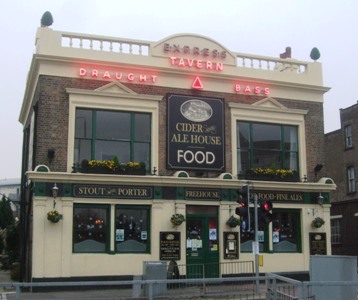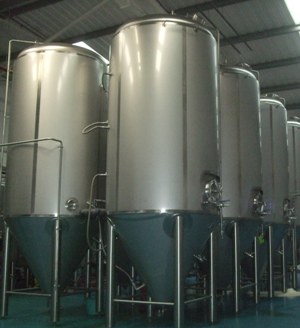As I recently wrote in London Drinker magazine, the young William Blake had a vision of angels in a tree on Peckham Rye Common. I had a revelation of a different kind in more-or-less the same spot. Towards the end of a lengthy six months researching 467 beer venues for the second edition of The CAMRA Guide to London’s Best Beer, Pubs and Bars (published on 2 July 2015), I visited a newly-opened shop, Hop Burns and Black, on East Dulwich Road. The first thing I saw when I walked in was a big shelf unit labelled “South East London”.
I stood in wonder for a while. Just four years previously, when the first edition of the book was in preparation, no more than two bottling breweries would have qualified for these shelves. Now there are approaching 25 potential suppliers. And ‘London beer’ is a term now insufficiently granular to express their geographic loyalties. Jen Ferguson, the shop’s New Zealand-born co-owner, confirmed these local beers sold the most, despite competition from some of the world’s greatest brewers on neighbouring shelves.
The facts put my little revelation in context. London was once the world beer capital but brewing here suffered relentless decline through the 20th century, culminating in a new low in 2006 when the closure of Young’s, one of our two remaining historic independents, left only nine breweries.
But then a trickle of promising start-ups appeared, and by 2010 the London Brewers Alliance had emerged specifically to promote London beer. Some of the newcomers were directly inspired to fill the gap left by Young’s, such as Duncan Sambrook, who told me early in 2011: “The London market’s so big, I think it could support all of us and more.” He couldn’t have known how right he was.
When I submitted the manuscript of the first edition in March 2011, Greater London had 14 operating commercial breweries including brewpubs, the highest figure since 1981, including some now-familiar names like the Kernel, Redemption and Sambrook’s. Just before the book went to press, we heard about another soon to start, Moncada, and congratulated ourselves on being so bang up-to-date by squeezing it in. As it turned out, Moncada encountered delays and didn’t finally launch until October, by which time another six breweries had appeared.
The brewery total by the end of 2011 was 22. A year later it was 36, already a higher tidemark than at the peak of the Firkin era in 1998. By the end of 2013 it was 45. When this edition was signed of early in 2015 it stood at 70, and by my calculations it’s since reached 75, almost certainly the highest figure since at least Victorian times.
While there have been a couple of casualties and a handful of short-lived projects since, the rest of the class of ’11 have grown significantly in size and capacity, Truman’s, then just a beer firm, is now supplying major pub chains from its own brewery at Hackney Wick, and many that appeared since have been forced to consider expansion plans within days of first opening the books. Beavertown has perhaps the most remarkable story – from a corner of a pub kitchen in February 2012, it’s expanded twice, and now has one of London’s most modern and capacious microbrewing setups in Tottenham.
Brewery numbers don’t equate to overall volume, of course, and many of the newcomers are still very small. Derek Prentice estimates that in the days of the Big Seven, nine or ten London breweries were producing seven million barrels (11.5 million hl) a year between them. Today, seven times the number of breweries barely manage one million barrels (1.6 million hl), and that’s including all the Bud lager currently made in Mortlake. But it’s hard to argue with the claim that the overall diversity in London, and the quality from the best brewers, has never been bettered.
One of the many positive aspects of the new wave’s fresh approach is the direct relationship brewers now cultivate with drinkers. The old breweries were industrial black boxes, but most of the current crop welcome the public to taprooms, open days and tours, and those that don’t would love to if only they had the facilities. Establishing this practice is one of Kernel founder Evin O’Riordan’s many achievements – his modest shop and taproom inspired a movement that has turned Bermondsey’s railway arches on Saturdays into an unlikely zythophiliac promenade.

One of the most welcome pub reopenings, the Express Tavern by Kew Bridge at Brentford.
Is there a downside to all this? Speaking to a US journalist recently, I noted the link between beer-friendliness and gentrification and all its attendant problems. Local microbrewers now press all the right buttons with prosperous arty metropolitan types, and as young middle class families move into deprived inner city areas like Hackney, Peckham and Walthamstow, small breweries and craft beer bars inevitably follow. And while I’m delighted to see fine old pubs in Homerton and Clapton lovingly restored as beer and food emporia with yoga classes and cycle repair workshops, I do wonder where the previous customers of these places now go to drink and meet their mates.
Devotees of traditional cask ales may also be concerned that much of the growth is elsewhere, in ‘craft keg’, bottles, cans and US-inspired styles. Pretty much every London brewer now produces a pale ale liberally dosed with New World hops, but a good few see no reason to offer a best bitter. I’ve even had to add a section on saison to the style guide.
Now, I’m an eclectic drinker: I love many of these new beers and the huge variety of flavour now on offer. But subtle, low gravity, gently carbonated cask session beer is something British brewers, almost uniquely, do well and it deserves pride of place in the capital. Pubs and many customers still very much want to drink it: several licensees told me they wished more London brewers did good cask. And more than one North American beer tourist has reminded me they visit London to drink great cask, not clones of beers they can easily find at home. Some brewers need to get better at overall consistency and quality too if London brewing is to secure its future.
Jaega Wise of Wild Card is one of several professionals who told me that “beer in London is now fashionable.” Indeed the archetype of the keen beer fan may even have shifted from the gent in jumper and sandals with an untidy beard pontificating over a pint of Old Crudginton’s to the snappily tonsured and tattooed Hackney hipster rhapsodising over the New Zealand and Japanese hop aromas in his, or increasingly her, two-thirds of Session IPA. But it’s an occupational hazard of being fashionable that you can rapidly and unexpectedly become unfashionable again at the flick of an eyebrow – is there a danger of this happening to London beer?
Peter Haydon, a fine brewer immersed in pub and beer history, says in the book that London won’t re-enter the premier league of beer cities “until Londoners at large think about their city and their beer in the same way as the citizens of Munich, Brussels, Denver and Bamberg do.”
I’m hopeful that we’re some way there, and great beer and world class brewing are already just about firmly enough re-embedded into London’s social and cultural fabric that they’ll survive fickle fashionistas finding something trendier to post about on their tablets.
Meanwhile one of the best things you and I can do to ensure this happens is to continue to enjoy the fruits of all this frenetic activity. So raise your glasses, please, for a toast to London brewing. You’ve certainly got the widest choice ever of appropriate libations – Beavertown Smog Rocket, Brick Peckham Pils, Brixton Electric IPA, By the Horns Lambeth Walk, Hammerton N7, The Kernel London Sour, Pressure Drop Stokey Brown, Redchurch Hoxton Stout, Redemption Hopspur or Sambrook’s Wandle are all possibilities that spring to mind.
But perhaps the most appropriately named beer with which to wish the London brewers health, long life and prosperity is still one of the oldest-established: Fuller’s London Pride.
The CAMRA Guide to London’s Best Beer, Pubs and Bars is published on 2 July 2015.







Leave a Reply